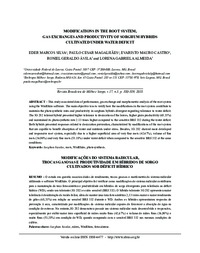Modifications in the root system, gas exchanges and productivity of sorghum hybrids cultivated under water deficit.
Modifications in the root system, gas exchanges and productivity of sorghum hybrids cultivated under water deficit.
Author(s): SILVA, E. M. da; MAGALHAES, P. C.; CASTRO, E. M.; ÁVILA, R. G.; ALMEIDA, L. G.
Summary: This study associated data of performance, gas exchange and morphometric analysis of the root system using the WinRhizo software. The main objective was to verify how the modifications in the root system contribute to maintain the photosynthetic rates and productivity in sorghum hybrids divergent regarding tolerance to water deficit. The 1G 282 tolerant hybrid presented higher tolerance to desiccation of the leaves, higher grain productivity (68.33%) and maintained its photosynthetic rate 2.13 times higher compared to the sensitive BRS 332 during the water deficit. Both hybrids presented responses related to desiccation prevention, characterized by modifications of the root system that are capable to benefit absorption of water and nutrients under stress. Besides, 1G 282 showed more developed and responsive root system, especially due to a higher superficial area of very fine roots (42.67%), volume of fine roots (36.90%) and very fine roots (53.18%) under water deficit when compared to the sensitive BRS 332 at the same conditions.
Publication year: 2018
Types of publication: Journal article
Unit: Embrapa Maize & Sorghum
Keywords: Fotossíntese, Raiz, Sorghum Bicolor, WinRhizo
Observation
Some of Embrapa's publications are published as ePub files. To read them, use or download one of the following free software options to your computer or mobile device. Android: Google Play Books; IOS: iBooks; Windows and Linux: Calibre.
Access other publications
Access the Agricultural Research Database (BDPA) to consult Embrapa's full library collection and records.
Visit Embrapa Bookstore to purchase books and other publications sold by Embrapa.

